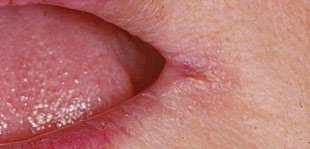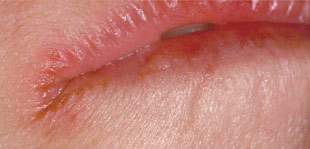Cracked Corners of the Mouth
Understanding angular cheilitis or perleche
Dear Doctor,
I have noticed cracking at the corners of my mouth, which lately won't seem to go away. What is it and what should I do?
Dear Joan,
Cracking of the corners of the mouth is a common condition that is frequently seen in both the offices of dermatologists and dentists. It is known as perleche or angular cheilitis (“angular” – angles; “cheil” – lip; “itis” – inflammation). Perleche is derived from the French word, “lecher,” meaning to lick, and is characterized by excessive licking of the affected areas — either as a result of irritation or because of it. This condition is further characterized by redness and cracking of the skin at the corners of the lips.
 |
 |
There can be a variety of causes with the majority of them being “local,” meaning they arise from inside or around the mouth. Although uncommon, systemic (bodily) diseases may predispose to perleche as well. Once the corners of the mouth are fissured or cracked, saliva accumulation and contamination can lead to infection. The most common infection is from yeast called, “candida albicans.”
Outside The Mouth Going In
Perleche is found most often in children and younger adults who drool during their sleep and/or have orthodontic braces. In older adults, part of the aging process causes skin wrinkling with superficial or deep lines extending from the mouth and down the chin called, “marionette lines.” Wrinkling is the result of skin thinning from sun damage and constant exposure to the environment over the years, and with fat and connective tissue loss, the lips thin as well. Perleche may be more evident in the winter with colder weather and drier air. Cracking of the corners of the mouth, and subsequent licking to keep them moist, sets the stage for infection.
Inside The Mouth Going Out
Conditions inside the mouth leading to perleche include anything that affects normal and healthy saliva flow or causes mouth dryness that in turn leads to infection.
Other causes include:
- Denture stomatitis (“stoma” – mouth; “itis” – inflammation) is an inflammation of the tissues under a denture. If dentures are not removed and cleaned regularly, dryness and subsequent chronic yeast infections can develop.
- A lack of teeth, especially the back teeth that support the face, cheeks and lips, can lead to bite collapse with subsequent cracking or fissuring at the corners of the mouth, also giving rise to a prematurely aged look.
- Systemic (general body) conditions like iron-deficiency anemia, B vitamin deficiency, diabetes and cancer can also lead to changes in the health and integrity of the oral mucous (mouth) membranes.
These conditions can predispose people to yeast infections, and perleche at the angles of the mouth.
Fixing The Cracks At The Corners
Chronic yeast infections may cause only minor discomfort while acute infections can affect the whole mouth and throat. In either case, they can be treated with a course of oral or topical antifungal (yeast) medication. Nystatin may be used as a troche (a small medicated lozenge designed to dissolve) that is rinsed with and then swallowed so that it works in the mouth and throughout the body. Antifungal ointments can also be applied liberally to the corners of the mouth several times a day to clear infection. They may be used in combination with a steroid ointment to control redness and inflammation, as well as zinc oxide paste or ointment, which is a barrier (skin) repair agent that has antifungal properties.
If infection arises from inside the mouth, it is likely to recur if only the corners of the mouth are treated. Chlorhexidine rinses can also be used to treat minor oral yeast infections. It is also effective for cleaning and scrubbing dentures; however, it is important to leave them out at night.
Optimal oral health and proper lip support from within the mouth can lessen or remove the cracking and wrinkles at the lip corners.
Although not as common, any systemic conditions that cause perleche will also need to be treated. Your dentist should also replace any missing teeth and ensure that dentures are properly fitting. Optimal oral health and proper lip support from within the mouth can lessen or remove the cracking and wrinkles at the lip corners. He/she should verify that oral hygiene is good, gum tissues are healthy and teeth decay free.
Modern dermatology can provide a variety of ways to treat lip wrinkles and marionette lines associated with perleche, and improve skin quality in general. This ranges from proper skin care to laser resurfacing. Facial fillers and fat may be used to replace the loss of connective tissue in the lips and provide support due to aging. Laser, fillers and other techniques can be used to remove both superficial and deep wrinkles and result in a healthier, rejuvenated appearance. This subject will be covered more fully in an upcoming issue of Dear Doctor magazine.




